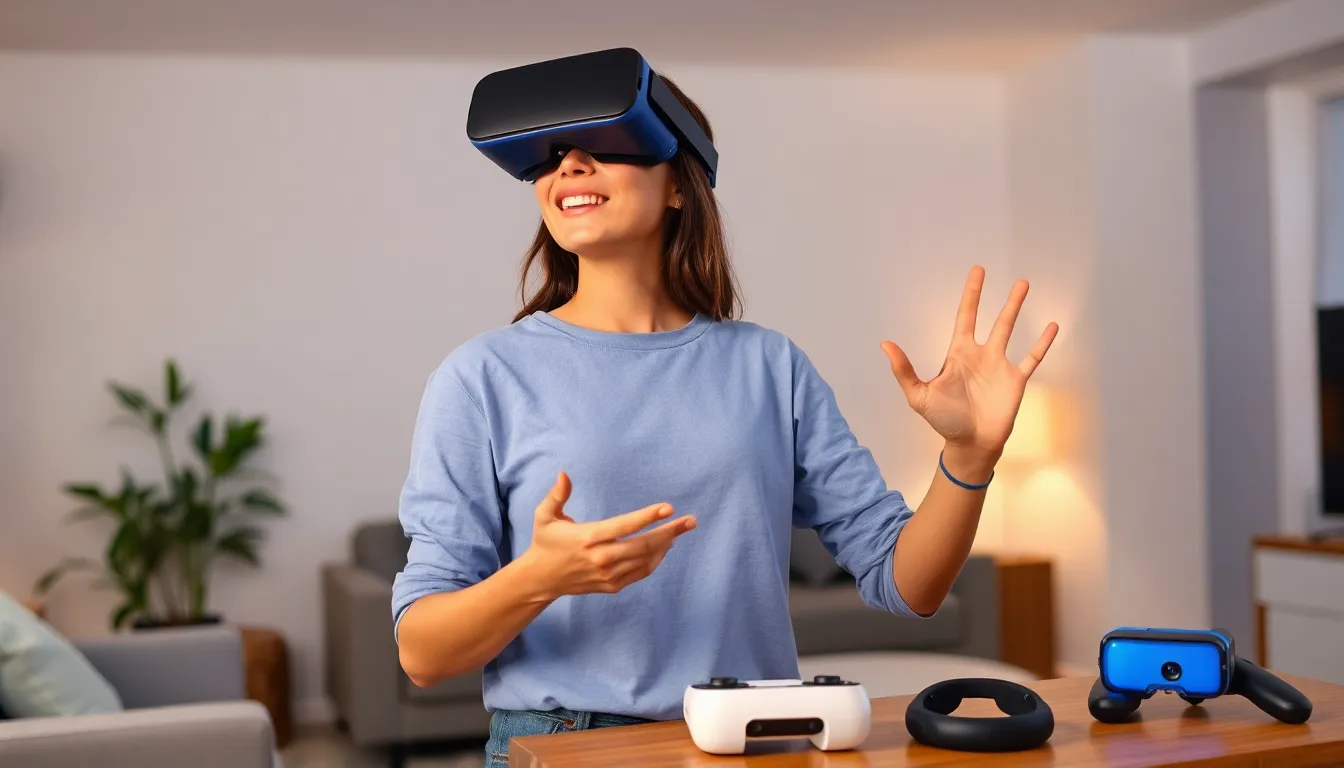In the world of interior design, turning dreams into reality can feel like a game of Tetris, where every piece must fit perfectly. Enter interior design rendering software, the superhero of the design realm. With its magical ability to transform flat sketches into stunning 3D visuals, it’s like having a crystal ball that shows clients exactly how their spaces will look—minus the fortune teller’s fees.
Imagine impressing clients with lifelike renderings that make them feel like they’re already walking through their future living room. This software doesn’t just elevate designs; it saves time and reduces costly mistakes. Whether you’re a seasoned designer or just starting out, embracing this technology is like upgrading from a flip phone to the latest smartphone. It’s time to ditch the guesswork and step into a world where creativity meets cutting-edge technology.
Table of Contents
ToggleOverview of Interior Design Rendering Software
Interior design rendering software serves as an essential tool for creating realistic visualizations of spaces. Designers create detailed 3D models from basic sketches, turning concepts into vivid images that clients can easily understand. This software not only enhances the design process, but it also bridges the gap between imagination and reality.
Numerous software options offer unique features. Programs like SketchUp and Autodesk 3ds Max provide intuitive interfaces, allowing designers to drag and drop elements into their designs. Users of these platforms can experiment with color schemes, furniture styles, and layouts before making final decisions.
Advanced rendering capabilities allow for high levels of detail. Realistic lighting, shadow effects, and material textures create immersive experiences. Clients appreciate the lifelike representations, which aid in decision-making and reduce misunderstandings about design intentions.
Collaboration tools integrate seamlessly into many software platforms. Designers can share their 3D renderings with clients and stakeholders, encouraging feedback and fostering communication. Consequently, stakeholders benefit, as they can visualize the space more effectively while contributing to the design process.
Time efficiency remains a significant advantage of rendering software. Designers save hours by generating instant visuals, enabling quicker revisions and faster project turnarounds. The need for physical mock-ups drops, minimizing costs and allowing for more flexibility in the design timeline.
Investing in quality rendering software provides long-term value. Firms that embrace this technology offer distinct competitive advantages, setting themselves apart in the ever-evolving design landscape. As the market continues to grow, staying updated with advancements ensures that designers deliver exceptional results.
Key Features to Consider
Interior design rendering software offers several key features that enhance the design process and improve client interactions.
User Interface and Usability
A simple user interface attracts designers. Intuitive navigation allows users to explore the software effortlessly. Many platforms provide customization options that meet individual workflows. Designers appreciate drag-and-drop functionality for easier layout management. Tooltips and tutorials support learning and quick adaptation for new users. Overall, seamless usability enhances productivity and streamlines project implementation.
Rendering Quality and Realism
High-quality renderings stand out in the design landscape. Realism in lighting and textures plays a crucial role in client presentations. Photorealistic visuals drive better understanding of spatial relationships. Advanced rendering engines increase detail, enabling accurate depictions of materials and finishes. Software that supports ray tracing provides realistic reflections and shadows. Such features enhance the overall impact of design presentations, allowing clients to envision their future spaces vividly.
Compatibility with Other Design Tools
Integration with other design tools significantly boosts workflow efficiency. Many rendering software options support popular formats like DWG and SKP. Compatibility ensures seamless transitions between platforms, reducing time spent on file conversions. Designers find it beneficial when software syncs with project management tools, fostering collaboration. By streamlining communication, project stakeholders stay aligned throughout the design process. A well-connected toolset ultimately enhances productivity and project outcomes.
Popular Interior Design Rendering Software
Various interior design rendering software options enhance design processes, making it easier for designers to create stunning visualizations. Below are some of the leading software programs available, highlighting their unique features and benefits.
Software 1: Features and Benefits
SketchUp stands out due to its user-friendly interface, which allows designers to easily draft and manipulate designs. An extensive library of 3D models offers users a wide selection of furniture and decor options, simplifying the design process. Real-time rendering capabilities enable immediate visual feedback, facilitating quick adjustments. Integration with various plugins extends functionality, allowing for additional features like lighting effects and texture enhancements. This software particularly benefits beginners with its approachable learning curve while remaining powerful enough for experienced designers.
Software 2: Features and Benefits
Autodesk 3ds Max excels in creating highly detailed and photorealistic renderings. It features advanced lighting systems and shader options, allowing designers to simulate real-world conditions accurately. A robust animation toolkit supports the creation of walkthroughs and presentations, enhancing client engagement. Users appreciate its compatibility with other Autodesk products, streamlining workflows across different projects. With extensive customization options, advanced users can tailor the software to fit specific project requirements, significantly improving productivity and outcome quality.
Software 3: Features and Benefits
Lumion provides real-time rendering and visualization, which enhances design presentations dramatically. Its intuitive interface allows users to create stunning environments swiftly, employing drag-and-drop functionality for ease of use. A vast library of materials and objects makes it simple to visualize almost any design concept. Professionals favor its powerful features, such as animated objects and realistic weather effects, which add depth to visualizations. Lumion’s cloud rendering capability ensures project accessibility from anywhere, perfect for collaborative efforts across teams.
Comparison of Pricing Models
Pricing models for interior design rendering software vary significantly, reflecting different user needs and capabilities. Monthly subscriptions often offer flexibility for freelancers or smaller firms. Annual plans typically reduce the overall cost, appealing to teams committed to long-term use. Usage-based pricing remains an option, allowing users to pay only for the rendering time they consume, which benefits projects with fluctuating demands.
Licensing costs differ among popular software options. SketchUp offers a free version with limited features, while its Pro edition starts at around $299 per year. Autodesk 3ds Max requires a higher investment, with pricing around $1,545 annually, but justifies the cost with advanced rendering tools. Lumion’s pricing is similarly structured, with their latest version starting at approximately $1,799, aimed at users needing high-quality renderings.
Additional expenses often accompany initial software purchases. Users may encounter costs for plugins to expand functionality or premium texture libraries for enhanced realism. Training might also be necessary, especially for more complex platforms, and investing in tutorials or courses can increase overall project budgets.
Support services further impact overall costs. Many software providers include basic customer support with subscriptions, while premium support often necessitates additional fees. Evaluating these aspects aids in understanding the true financial commitment involved in selecting rendering software.
Comparative analysis of pricing models helps designers select software aligned with their budget and project requirements. Understanding the cost structure enables informed decision-making, ensuring the right tool is chosen for optimal project outcomes.
Embracing interior design rendering software is a game changer for designers at any level. These tools not only streamline the design process but also enhance communication with clients and stakeholders. With the ability to create stunning 3D visuals and realistic renderings, designers can bring their visions to life more effectively than ever before.
Investing in the right software can lead to significant time and cost savings while improving overall project quality. As technology continues to evolve, staying updated with the latest rendering options will ensure designers remain competitive in a fast-paced industry. By integrating these powerful tools into their workflow, designers can elevate their creative potential and deliver exceptional results that resonate with clients.




